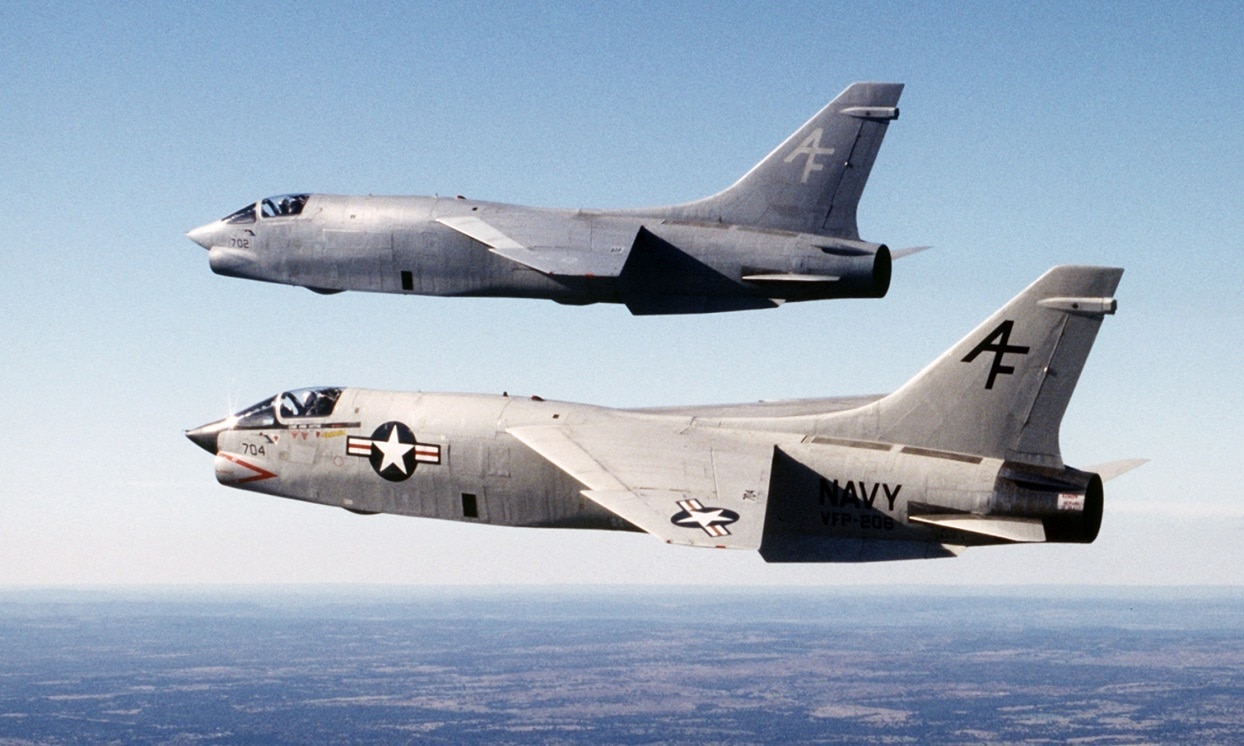Thinking back to my 19FortyFive article on the A-7 Corsair II , I couldn’t help but notice that it looked like a compacted – is it too politically incorrect to say “dwarf” or “midget” nowadays(?) – version of the F-8 Crusader. Upon further review, looks in this case actually are not deceiving, as the Crusader was indeed the direct predecessor/parent of the so-called “SLUF” (“Short Little Ugly Fucker”).
However, unlike its subsonic “ugly duckling” (so to speak) progeny, which was purely a ground attack plane – there is only one known instance of a Corsair II pilot engaging in air-to-air combat. The F-8 was designed as a sleek, supersonic fighter plane.
Let’s now delve deeper into the Crusader’s history (not to be confused with medieval Crusader history, of course).
Creation of the Crusader
The Crusader made her maiden flight on March 25, 1955, and officially entered U.S. Navy service two years later. The impetus for the warbird’s creation goes back to September 1952—a mere 4 years and 11 months after Chuck Yeager broke the sound barrier—when the Navy issued specifications for a new carrier-based fighter with the capability to exceed the speed of sound in routine level flight.
Chance-Vought (nowadays known as Triumph Aerostructures) already had an excellent reputation in the eyes of the Navy and Marine Corps brass thanks to the performance of the original Corsair – the prop-driven WWII fighter plane – so it’s not entirely surprising that they ended up winning this particular bid.
It didn’t take long for the F-8 to leave a positive first impression and for its pilots to nail their names in the pages of history. Commander Robert W. “Duke” Windsor established a national speed record on August 21, 1956, reaching 1,015.428 mph (1,323 kmh/Mach 1.333) over a 15-kilometer course; in the process, the F-8 became the first armed jet aircraft to fly faster than 1,000 mph (1,609.34 kph/Mach 1.313). For this accomplishment, “Duke” was awarded the 1956 Thompson Trophy.
Fast-forward to July 16, 1957, and then-Lt. Col. John Glenn – perhaps his name rings a bell (?) – piloted an F8U-1P variant from Los Angeles to New York in three hours, 23 minutes, 8.4 seconds, for an average speed of 726 mph (1,168 kph/Mach 1.1). This achievement earned Glenn one of his six Distinguished Flying Crosses. As icing on the cake, in December of that same year, Vought won the Robert J. Collier Trophy for having designed the Crusader.
These speed records would soon be topped by the F-4 Phantom. But just like with the Phantom, the Crusader wasn’t built to win air races, but rather to fight, and when the Vietnam War rolled around, the F-8 would at least initially one-up the F-4 in a very important life-or-death category: reputation as a dogfighter.
“Last of the Gunfighters”
Much has been made of the fact that early versions of the Phantom lacked a gun and relied solely on air-to-air missiles, which were less than wholly reliable at that point in time, and would cost F-4 drivers dearly when tangling with North Vietnam’s more nimble and cannon-armed MiG-17 “Frescoes” and MiG-21 “Fishbeds.” In refreshing contrast, the F-8 earned the sobriquet “The Last of the Gunfighters” (not to be confused with the 1984 sci-fi movie The Last Starfighter) as it was the final American fighter built with guns as its primary weapon. Specifically, those guns were four Colt Mk 12 20mm cannons, backed up by four AIM-9 Sidewinder heat-seeking missiles.
Besides the cannon, another advantage the Crusader had that the Phantom lacked was the agility that made it feasible to dogfight – which wasn’t yet an outmoded art of aerial warfare – against the highly maneuverable MiGs. Interestingly though, F-8 drivers only scored four air-to-air kills with their guns – which could sometimes jam during high-speed twists and turns – and therefore actually scored the rest of their aerial victories with their Sidewinders.
Nonetheless, the Crusader earned bragging rights to the best kill ratio of any American aircraft type in the Vietnam War, that being 19:3. Three of these victims were MiG-21s and the rest were MiG-17s.
Where Are They Now?
A total of 1,219 F-8s were built. The Navy retired the plane in 1976 after nearly two decades of service, remarkably a first for a naval fighter. The Philippine Air Force kept their Crusaders flying until 1991, whilst the French Air Force – perhaps fittingly for a country that participated in the original Crusades – did so until December 1999, just shy of the new millennium.
Today, F-8 static displays can be found in multiple aviation museums in France, the Philippines, and the U.S, including the Steven F. Udvar-Hazy Center in Chantilly, VA.
Christian D. Orr is a former Air Force officer, Federal law enforcement officer, and private military contractor (with assignments worked in Iraq, the United Arab Emirates, Kosovo, Japan, Germany, and the Pentagon). Chris holds a B.A. in International Relations from the University of Southern California (USC) and an M.A. in Intelligence Studies (concentration in Terrorism Studies) from American Military University (AMU). He has also been published in The Daily Torch and The Journal of Intelligence and Cyber Security. Last but not least, he is a Companion of the Order of the Naval Order of the United States (NOUS).
FROM 19FortyFive: How To Sink A $3 Billion Dollar Submarine: Leave A Hatch Open
FROM 19FortyFive – Ukraine War Ending: Putin Sick with Cancer and Passes Away?
FROM 19FortyFive – Ukraine War Ending: Putin Gets Wiped Out in Coup?

